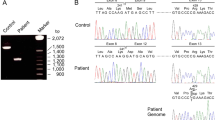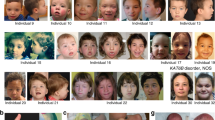Abstract
Bardet-Biedl syndrome (BBS, OMIM 209900) is a genetic disorder with the primary features of obesity, pigmentary retinopathy, polydactyly, renal malformations, mental retardation and hypogenitalism1,2,3,4. Individuals with BBS are also at increased risk for diabetes mellitus, hypertension and congenital heart disease4,5,6. What was once thought to be a homogeneous autosomal recessive disorder is now known to map to at least six loci: 11q13 (BBS1), 16q21 (BBS2), 3p13–p12 (BBS3), 15q22.3–q23 (BBS4), 2q31 (BBS5) and 20p12 (BBS6)7,8,9,10,11,12,13. There has been considerable interest in identifying the genes that underlie BBS, because some components of the phenotype are common. Cases of BBS mapping ro BBS6 are caused by mutations in MKKS12,13; mutations in this gene also cause McKusick-Kaufman syndrome (hydrometrocolpos, post-axial polydactyly and congenital heart defects)14,15. In addition, we recently used positional cloning to identify the genes underlying BBS2 (ref. 16) and BBS4 (ref. 17). The BBS6 protein has similarity to a Thermoplasma acidophilum chaperonin15, whereas BBS2 and BBS4 have no significant similarity to chaperonins. It has recently been suggested that three mutated alleles (two at one locus, and a third at a second locus) may be required for manifestation of BBS (triallelic inheritance)18. Here we report the identification of the gene BBS1 and show that a missense mutation of this gene is a frequent cause of BBS. In addition, we provide data showing that this common mutation is not involved in triallelic inheritance.
This is a preview of subscription content, access via your institution
Access options
Subscribe to this journal
Receive 12 print issues and online access
$209.00 per year
only $17.42 per issue
Buy this article
- Purchase on Springer Link
- Instant access to full article PDF
Prices may be subject to local taxes which are calculated during checkout




Similar content being viewed by others
Accession codes
References
Bardet, G. Sur un syndrome d'obesite infantile avec polydactylie et retinite pigmentaire (contribution a l'etude des formes cliniques de l'obesite hypophysaire). Thesis, Univ. of Paris, Note: No. 479 (1920).
Biedl, A. Ein Geschwisterpaar mit adiposo-genitaler Dystrophie. Dtsch. Med. Wschr. 48, 1630 (1922).
Solis-Cohen, S. & Weiss, E. Dystrophia adiposogenitalis, with atypical retinitis pigmentosa and mental deficiency, possibly of cerebral origin: a report of four cases in one family. Trans. Assoc. Am. Phys. 39, 356–358 (1924).
Green, J.S. et al. The cardinal manifestations at Bardet-Biedl syndrome, a form of Laurence-Moon-Biedl syndrome. New Engl. J. Med. 321, 1002–1009 (1989).
Harnett, J.D. et al. The spectrum of renal disease in Laurence-Moon-Biedl syndrome. New Engl. J. Med. 319, 615–618 (1988).
Elbedour, K., Kucker, N., Zalstein, E., Barki, Y. & Carmi, R. Cardiac abnormalities in the Bardet-Biedl syndrome: echocardiographic studies of 22 patients. Am. J. Med. Genet. 52, 164–169 (1994).
Leppert, M. et al. Bardet-Biedl syndrome is linked to DNA markers on chromosome 11q and is genetically heterogeneous. Nature Genet. 7, 108–112 (1994).
Kwitek-Black, A.E. et al. Linkage of Bardet-Biedl syndrome to chromosome 16q and evidence for non-allelic genetic heterogeneity. Nature Genet. 5, 392–396 (1993).
Sheffield, V.C. et al. Identification of a Bardet-Biedl syndrome locus on chromosome 3 and evaluation of an efficient approach to homozygosity mapping. Hum. Mol. Genet. 3, 1331–1335 (1994).
Carmi, R. et al. Use of a DNA pooling strategy to identify a human obesity syndrome locus on chromosome 15. Hum. Mol. Genet. 4, 9–13 (1995).
Young, T.-L. et al. A fifth locus for Bardet-Biedl syndrome maps to chromosome 2q31. Am. J. Hum. Genet. 64, 901–904 (1999).
Slavotinek, A.M. et al. Mutations in MKKS cause Bardet-Biedl syndrome. Nature Genet. 26, 15–16 (2000).
Katsanis, N. et al. Mutations in MKKS cause obesity, retinal dystrophy and renal malformations associated with Bardet-Biedl syndrome. Nature Genet. 26, 67–70 (2000).
Robinow, M. & Shaw, A. The McKusick-Kaufman syndrome: recessively inherited vaginal atresia, hydrometrocolpos, uterovaginal duplications, anorectal anomalies, postaxial polydactyly, and congenital heart disease. J. Pediatr. 94, 776–778 (1979).
Stone, D.L. et al. Mutation of a gene encoding a putative chaperonin causes McKusick-Kaufman syndrome. Nature Genet. 25, 79–82 (2000).
Nishimura, D.Y. et al. Positional cloning of a novel gene on chromosome 16q causing Bardet-Biedl syndrome (BBS2). Hum. Mol. Genet. 10, 865–874 (2001).
Mykytyn, K. et al. Identification of the gene, that when mutated, causes the human obesity syndrome BBS4. Nature Genet. 28, 188–191 (2001).
Katsanis, N. et al. Triallelic inheritance in Bardet-Biedl syndrome, a Mendelian recessive disorder. Science 293, 2256–2259 (2001).
Katsanis, N. et al. Delineation of the critical interval of Bardet Biedl syndrome 1 (BBS1) to a small region of 11q13, through linkage and haplotype analysis of 91 pedigrees. Am. J. Hum. Genet. 65, 1672–1679 (1999).
Young, T-L. et al. A founder effect in the Newfoundland population reduces the Bardet-Biedl syndrome 1 (BBS1) interval to 1 cM. Am. J. Hum. Genet. 65, 1680–1687 (1999).
Bassam, B.J., Caetano-Anolles, G. & Gresshoff, P.M. Fast and sensitive silver staining of DNA in polyacrylamide gels. Anal. Biochem. 196, 80–83 (1991).
Altschul, S.F., Gish, W., Miller, W., Myers, E.W. & Lipman, D.J. Basic local alignment search tool. J. Mol. Biol. 215, 403–410 (1990).
Acknowledgements
We are grateful to the patients and their families for their participation in this study. We thank G. Beck, K. Bugge, R. Englehardt, J. Andorf and A. Nalley for technical assistance, and D. Aguiar-Crouch for administrative assistance. We thank M. Berg for important contributions to the genetic mapping of the BBS1 locus. We also wish to thank L.G. Biesecker for advice and many helpful suggestions. This work was supported by grants from the following organizations: National Institutes of Health (to V.C.S. and E.M.S.), Foundation Fighting Blindness (to S.G.J., E.M.S. and V.C.S.), Carver Endowment for Molecular Ophthalmology (to E.M.S. and V.C.S.) and Research to Prevent Blindness (to Dept. of Ophthalmology, Univ. of Iowa). V.C.S. is an associate investigator of the Howard Hughes Medical Institute.
Author information
Authors and Affiliations
Corresponding author
Ethics declarations
Competing interests
The authors declare no competing financial interests.
Supplementary information
Rights and permissions
About this article
Cite this article
Mykytyn, K., Nishimura, D., Searby, C. et al. Identification of the gene (BBS1) most commonly involved in Bardet-Biedl syndrome, a complex human obesity syndrome. Nat Genet 31, 435–438 (2002). https://doi.org/10.1038/ng935
Received:
Accepted:
Published:
Issue Date:
DOI: https://doi.org/10.1038/ng935
This article is cited by
-
Reanalysis of clinical exome identifies the second variant in two individuals with recessive disorders
European Journal of Human Genetics (2023)
-
The dominant findings of a recessive man: from Mendel’s kid pea to kidney
Pediatric Nephrology (2023)
-
LPA signaling acts as a cell-extrinsic mechanism to initiate cilia disassembly and promote neurogenesis
Nature Communications (2021)
-
Whole exome sequencing uncovered highly penetrant recessive mutations for a spectrum of rare genetic pediatric diseases in Bangladesh
npj Genomic Medicine (2021)
-
Genetic landscape of 6089 inherited retinal dystrophies affected cases in Spain and their therapeutic and extended epidemiological implications
Scientific Reports (2021)



